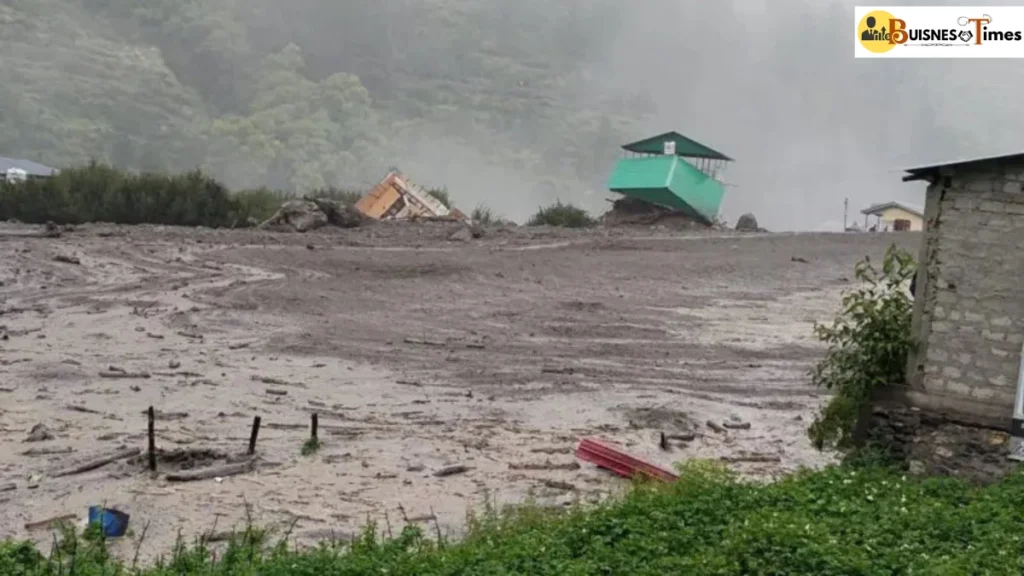
A devastating cloudburst struck Uttarkashi district in Uttarakhand on Tuesday, bringing unprecedented destruction to the region. The sudden surge in the water level of the Kheer Ganga stream in the Harsil Valley led to massive flooding in Dharali village, sweeping away homes, hotels, and temples in its path.
Local authorities have so far confirmed the deaths of four people, while several others remain missing. Many homes and businesses have been severely damaged or entirely submerged. Uttarkashi District Magistrate Prashant Arya confirmed the casualties and property losses and assured that search and rescue operations are ongoing.
However, residents claim the actual scale of destruction is far worse. People describe scenes of chaos, watching helplessly as powerful waves destroyed everything in their way. The water brought along mud and debris, submerging even three-story hotels within minutes.
Uttarkashi Eyewitness Accounts of the Disaster
Astha Pawar, a resident of Dharali, gave a chilling account of the incident:
“I saw hotels being swept away in front of my eyes. The first wave was brutal, but the danger didn’t stop there. Every 10 to 20 minutes, new waves of mud and debris came, wiping out more structures. Nothing was spared. The power of nature was beyond terrifying.”
She added, “If the cloudburst had occurred during the night, during our religious ceremony, the casualties would have been far worse. It’s a miracle more lives weren’t lost.”
Uttarkashi Lack of Warning and Preparedness
Astha and other villagers raised concerns over the lack of early warnings.
“There was no alarm. No message. Children even went to school that morning,” she said. “In a place so prone to natural disasters, this level of unpreparedness is unacceptable.”
No alerts were reportedly issued by the meteorological department, and locals were caught completely off guard. The disaster highlights the urgent need for improved forecasting systems and community-level alerts.
Uttarkashi Massive Infrastructure Loss and Cultural Impact
The destruction was not limited to homes. The local marketplace, once buzzing with pilgrims and tourists, is gone. Kalp Kedar Temple, a significant spiritual site in Dharali, is also believed to have been severely damaged or entirely washed away.
“Uttarkashi Hotels, shops, temples, everything is gone. All we see now is debris and silence,” said another local, visibly shaken.
Dharali lies on the Char Dham Yatra route. Many pilgrims rest in this region during their journey to Gangotri, and with infrastructure wiped out, future travel will likely be affected until restoration is complete.
Uttarkashi Climate Change and Fragile Himalayan Ecosystem
This disaster is a stark reminder of how vulnerable the Himalayan region is to climate change. Scientists have long warned that rising global temperatures are increasing the frequency and intensity of cloudbursts, landslides, and flash floods.
Environmentalist Dr. Sameer Joshi noted,
“The Himalayas are ecologically fragile. Uncontrolled development, deforestation, and inadequate drainage infrastructure amplify the risk. We’re seeing the consequences of not respecting natural boundaries.”
Experts are calling for a comprehensive review of construction policies in disaster-prone regions, especially for high-altitude tourist zones like Uttarkashi.
Rescue, Relief, and Government Response
Prime Minister Narendra Modi and Home Minister Amit Shah expressed condolences and assured all help from the central government. CM Pushkar Singh Dhami confirmed that rescue operations are in full swing.
ITBP and NDRF teams have been deployed for search-and-rescue. Temporary relief camps have been set up for displaced residents, offering shelter, food, and medical assistance.
A senior NDRF officer said,
“It will take days to fully assess the damage. Our immediate priority is to find missing persons and restore basic services.”
The government has also announced a compensation package for the families of those who lost their lives, and for damaged property and businesses.
Role of NGOs and Volunteers
In addition to government forces, NGOs such as Goonj, Save the Himalayas, and local religious organizations have joined relief efforts. Volunteers are helping distribute food, medicine, and clean water.
Mobile medical vans have been sent to remote areas to treat injuries and prevent water-borne diseases. Mental health support is also being provided to trauma-affected villagers.
Long-term Rebuilding and Future Prevention
The scale of destruction has triggered debates on long-term planning. Experts suggest:
- Establishment of a real-time weather monitoring system
- Construction of flood-resistant buildings
- Development of emergency evacuation plans
- Community-based disaster awareness programs
“This cannot be a one-time response,” says Dr. Joshi. “We need sustainable solutions — not just roads and hotels, but systems that work with nature, not against it.”
The Uttarkashi cloudburst is a heartbreaking tragedy, a wake-up call, and an opportunity to rebuild with resilience. As relief work continues, one message is clear: nature’s fury respects no boundaries. Without timely preparedness, the loss becomes irreversible.